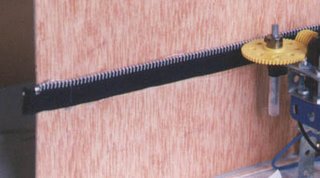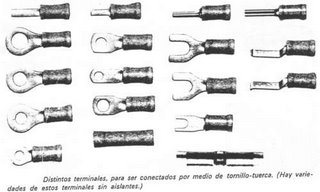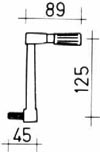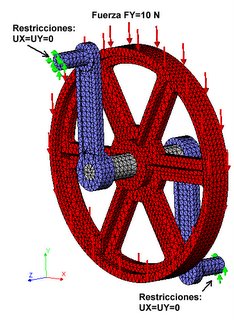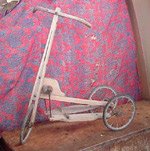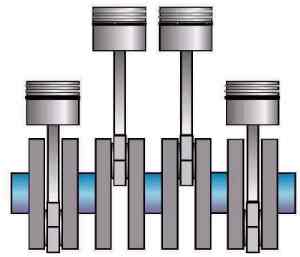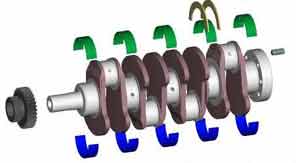LEVERS ACTIVITIES :
1. We have to lift 30kg of rubble with a wheelbarrow. The distance between the debris and the wheel is 25cm and the strength that I do is half of what they weigh the rubble. How far will my hand from the rubble?
Solution: Formula F × f = R * R
15 · x = 25.30
15 · x = 750 x = 750/15
x = 50cm
2. Two boys are playing on the swing in the park. The distance between the two sides of the swing and the center is half a meter (50 cm) one child weighs 25kg. How weigh the other child to lift?
Solution: Formula F × f = R * R
25.50 = x • 50
1250 = x • 50
1250/50 = x
25 = x
If weighing 25kg equates it with weighing 25 eat something and raise it.
3. I have a lever that is 13cm in distance between the fulcrum and the resistance. If the resistance weighs 10kg and the strength that I do is of 2Kg, how far is the strength that I do and the fulcrum?
Solution: Formula F × f = R * R
2 • x = 10.13
2 •
x = 130 x = 130 / 2 x = 65
4. I cut a paper by a force of 5kg. If the distance between the fulcrum and the resistance is 5 cm and between the fulcrum and the force is 2 cm, what is the resistance have to do the folio?
Solution: Formula F × f = R * R
x 5.2 = 5 •
10 / 5 = 5 ° x 2 = x
5. I want to get a nail opposing resistance 2kg and I do a force of 6kg. If the distance between the fulcrum and the force is 4cm how much is the distance between the point of support and resistance?
Solution: Formula F × f = R * R
2.6 = 3 ° x 18 = 3.x
18 / 3 = x
6 = x
Wednesday, March 29, 2006
Industrial Recycling Bins
Wednesday, March 22, 2006
M&b Wedding Dance Giude
MECHANISMS OF TRANSFORMATION OF MOTION
processing mechanisms in straight circular motion .
1.- Sistema piñón-cremallera.
Es un piñón o rueda dentada de dientes rectos, engarzado a una cremallera, se desplaza con movimiento rectilíneo.
Este mecanismo permite transformar el movimiento rectilíneo en un movimiento circular, es un mecanismo reversible. Se utiliza en sacacorchos, etc.
2.- Sistema tornillo-tuerca.
Consta de un tornillo y de una tuerca (como su propio nombre indica), cuyo diámetro coincide con el del tornillo. Si el tornillo turning the nut moves with a linear motion, provided that the orientation remains fixed, and vice versa. It is used in screw caps, etc.
3 .- Joint-winch handle.
A handle is a bar that is attached to a shaft that spins. The force required to rotate is less than it would have to apply directly. The mechanism is the lathe, which consists of a drum that rotates around its axis in order to drag an object.
A lathe is in equilibrium when it meets this equation:
F × f = R * R
F = R * R / d
equalities in "F is the force applied.
-f: is the radius of the crank.
-R: the resistance.
-r: is the radius of the lathe.
Ryd If the ratio is small enough, the winch will lift weights with little effort.
Transformation mechanisms of circular motion in straight alternative.
1 .- rod-crank assembly.
is formed (as the name suggests) with a handle and a bar called crank. Is articulated at one end to said crank and the other with an element describing a reciprocating motion.
rotate the wheel, crank transmits the circular movement of the rod. This system also works in reverse. It is used in machine tools, etc..
Examples of application of the rod-crank mechanism
* crankshaft.
Placing a series of cranks on the same axle, each axle elbows acts as a crank, and crank set is called.
The crankshaft transforms the rotation movement of step alternative movements of rods. You can also convert reciprocating push rods in a rotational movement.
This mechanism is used in combustion engines, sewing machines, etc.
Examples combustion engine crankshaft
Máquina de coser
2.- Leva y excéntrica.
La leva es, una rueda con un saliente que empuja un seguidor a su paso. Se pueden añadir más salientes e introducir perfiles más o menos abruptos para conseguir movimientos más complejos.
De este modo, la leva transforma el movimiento de rotación de la rueda en un movimiento lineal del seguidor o varilla, que recorre el perfil de la leva cuando esta gira.
Un conjunto de levas colocadas sobre el mismo eje se denomina árbol de levas.
La excéntrica consiste en una rueda cuyo eje de giro no coincide con el centro de la circunferencia. Transforma el movimiento de rotación wheel in a reciprocating linear movement of the rod.
Camshaft
Monday, March 6, 2006
Can We Bathe Immediately After Waxing?
What is a lever?
is a simple machine consisting of a bar that pivots on a fulcrum.
What is the point?
serves to easily move loads by increasing the strength or power. The levers also amplify the movement.
What are its components?
Barra, fulcrum, and load power
In what types are there?
In first grade, second grade and third grade.
What is the difference between the different types?
In first grade : The fulcrum is between the power and load.

The object is the load weight, and counterweights to balance the force carried out the mechanism. Both weights are equal and are at the same distance.
In second grade : The fulcrum is at one end and the power and
load the other.
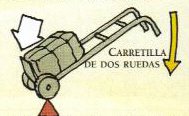
By raising the poles is possible to lift a heavy load that is closer to the fulcrum, the wheel.
In third grade : The power is between the fulcrum and load.

A pair of tweezers is a third grade composite handle. The effort exerted by the fingers is reduced at the ends of the clamp, which allows you to take aim
Sunday, March 5, 2006
Vidya Balan Blouse Design In Parineeta
Machine: A machine is a set of moving parts and non-mobile, that the effect of its links are capable of transforming energy.
simple machine: A simple machine is a device that only requires the application of force to operate.
Mechanism: in mechanical mechanism is called a set of rigid elements, moving from one another, whose purpose is the transmission of motion and strength.
Lever Act: The product of his arm strength is equal to the strength of his:
FxBf = RxBr
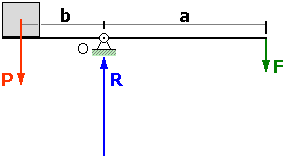
elements involved in this act:
R: Resistance
r: resistance arm
F: Force
f: arm strength
Problem: A lever has arm force 2 m resistance arm 4 m. If want lift a weight (or Resistencia) 100 Kg What force'll do?
F * f = R * r
F * 2 = 100 * 4
F = 400 / 2
F = 200
Subscribe to:
Posts (Atom)
